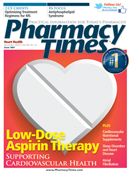Publication
Article
Pharmacy Times
Drug Interactions with Marijuana
Marijuana has been approved for recreational use in 2 states and for medicinal use in about 20 states. Of course, the unapproved use of marijuana is fairly common. In addition to its recreational use, marijuana has been used (1) to control chemotherapy-induced nausea and vomiting and (2) as an analgesic, antispasmodic, appetite-stimulating agent, sedative, antiepileptic, and euphoric. Side effects associated with tetrahydrocannabinol (THC) include sedation, euphoria, dizziness, ataxia, tachycardia, hypotension, dry mouth, anxiety, and paranoia. THC is the primary psychoactive constituent of marijuana, but the plant contains more than 50 cannabinoids.
In addition to THC, cannabidiol (CBD) is found in high concentrations in marijuana. CBD does not produce any of the psychoactive responses and appears to block some of the effects of THC by acting as an antagonist at the cannabinoid receptors. Cannabinol is weakly psychoactive and appears to be primarily formed from the metabolism of THC. Another metabolite of THC is thought to contribute to the tachycardia and appetite-stimulating effects of cannabis.1,2
The common natural sources of THC are Cannabis sativa and Cannabis indica. These differ in that C sativa is known to produce more of a “high” and lively feeling than C indica, which tends to produce a more relaxed feeling. This difference in response may be due to the THC:CBD ratios in the 2 plants. C sativa usually has a higher concentration of THC, while CBD predominates in C indica.
Commercial preparations of oral THC are available as dronabinol (Marinol) and nabilone (Cesamet). Both of these preparations only contain THC without any CBD. Thus, the pharmacologic effect of these products may differ from that of natural cannabis.
Unfortunately, few data are available regarding the potential drug interactions associated with marijuana. Nevertheless, we can make some predictions of potential interactions based on the known pharmacology of marijuana.
Potential Drug Interactions
Tetrahydrocannabinol
THC is metabolized by CYP2C9 and CYP3A4.3 Patients who are poor metabolizers of CYP2C9 have been shown to have THC concentrations that are about 3-fold higher than those of extensive metabolizers of CYP2C9.4 We are unaware of any studies examining the effect of CYP2C9 inhibitors on the elimination of THC. Based on genetic studies, inhibitors of CYP2C9 would be expected to increase the plasma concentration of THC. CYP2C9 inhibitors that would be expected to inhibit THC elimination include amiodarone, cimetidine, cotrimoxazole, metronidazole, fluoxetine, fluvoxamine, fluconazole, and voriconazole.
Ketoconazole, an inhibitor of CYP3A4, has been reported to increase the peak concentration and area under the concentration time curve of THC by 1.2- and 1.8- fold, respectively, with greater increases in the concentration of THC metabolites.5 Other CYP3A4 inhibitors, including clarithromycin, erythromycin, cyclosporine, verapamil, itraconazole, voriconazole, and boceprevir, would be expected to produce similar increases in THC concentrations. Conversely, rifampin, a CYP3A4 inducer, has been reported to reduce THC levels by 20% to 40%.
Cannabidiol
CBD is a substrate of CYP3A4 and CYP2C19.6 Similar to THC, ketoconazole was noted to increase the plasma concentration of CBD by about 2-fold, while rifampin reduced CBD levels by 50% to 60%. Other CYP3A4 inhibitors and inducers should be expected to have a similar effect on CBD plasma concentrations if coadministered. Omeprazole, a modest inhibitor of CYP2C19, did not alter the plasma concentration of CBD in one study.5
Effects of Marijuana on Other Drugs
In vitro studies indicate that THC and CDB have limited ability to inhibit the activity of CYP450 enzymes. One case report noted an increased response to warfarin in a patient smoking 4 to 5 joints of marijuana per week.7 Smoked marijuana, but not oral administration, has been shown to increase the metabolism of theophylline and chlorpromazine, with about a 50% reduction in their plasma concentrations.8 This is thought to be due to induction of CYP1A2 by smoking more than 2 joints of marijuana per week.
Additionally, pharmacodynamic interactions should be expected between marijuana and drugs with sympathomimetic activity (tachycardia, hypertension), central nervous system depressants (drowsiness, ataxia), and drugs with anticholinergic effects (tachycardia, drowsiness). Pending additional studies, patients taking THC should be counseled to avoid drugs that alter the activity of CYP3A4 and CYP2C9. Smoking more than a couple of joints weekly is likely to result in induction of CYP1A2 activity.
Drs. Horn and Hansten are both professors of pharmacy at the University of Washington School of Pharmacy. For an electronic version of this article, including references, if any, visit www.hanstenandhorn.com.
References
1. Ahrens J, Demir R, Leuwer M, et al. The nonpsychotropic cannabinoid cannabidiol modulates and directly activates alpha-1 and alpha-1-beta glycine receptor function. Pharmacology. 2009;83:217-222.
2. Fusar-Poli P, Bhattacharyya S, Allen P, et al. Distinct effects of delta 9-tetrahydrocannabinol and cannabidiol on neural activation during emotional processing. Arch Gen Psychiatry. 2009;66:95-105.
3. Watanabe K, Yamaori S, Funahashi T, et al. Cytochrome P450 enzymes involved in the metabolism of tetrahydrocannabinols and cannabinol by human hepatic microsomes. Life Sci. 2007;80:1415-1419.
4. Sachse-Seeboth C, Pfeil J, Sehrt D, et al. Interindividual variation in the pharmacokinetics of delta9-tetrahydrocannabinol as related to genetic polymorphisms in CYP2C9. Clin Pharmacol Ther. 2009;85:273-276.
5. Stout SM, Cimino NM. Exogenous cannabinoids as substrates, inhibitors, and inducers of human drug metabolizing enzymes: a systematic review. Drug Metab Rev. 2014;46:86-95.
6. Jiang R, Yamaori S, Takeda S, et al. Identification of cytochrome P4540 enzymes responsible for metabolism of cannabidiol by human liver microsomes. Life Sci. 2011;89:165-170.
7. Yamreudeewong W, Wong HK, Brausch LM, et al. Probable interaction between warfarin and marijuana smoking. Ann Pharmacother. 2009;43:1347-1353.
8. Jusko WJ, Gardner MJ, Mangione A, et al. Factors affecting theophylline clearances: age, tobacco, marijuana, cirrhosis, congestive heart failure, obesity, oral contraceptives, benzodiazepines, barbiturates, and ethanol. J Pharm Sci. 1979;68:1358-1366.







